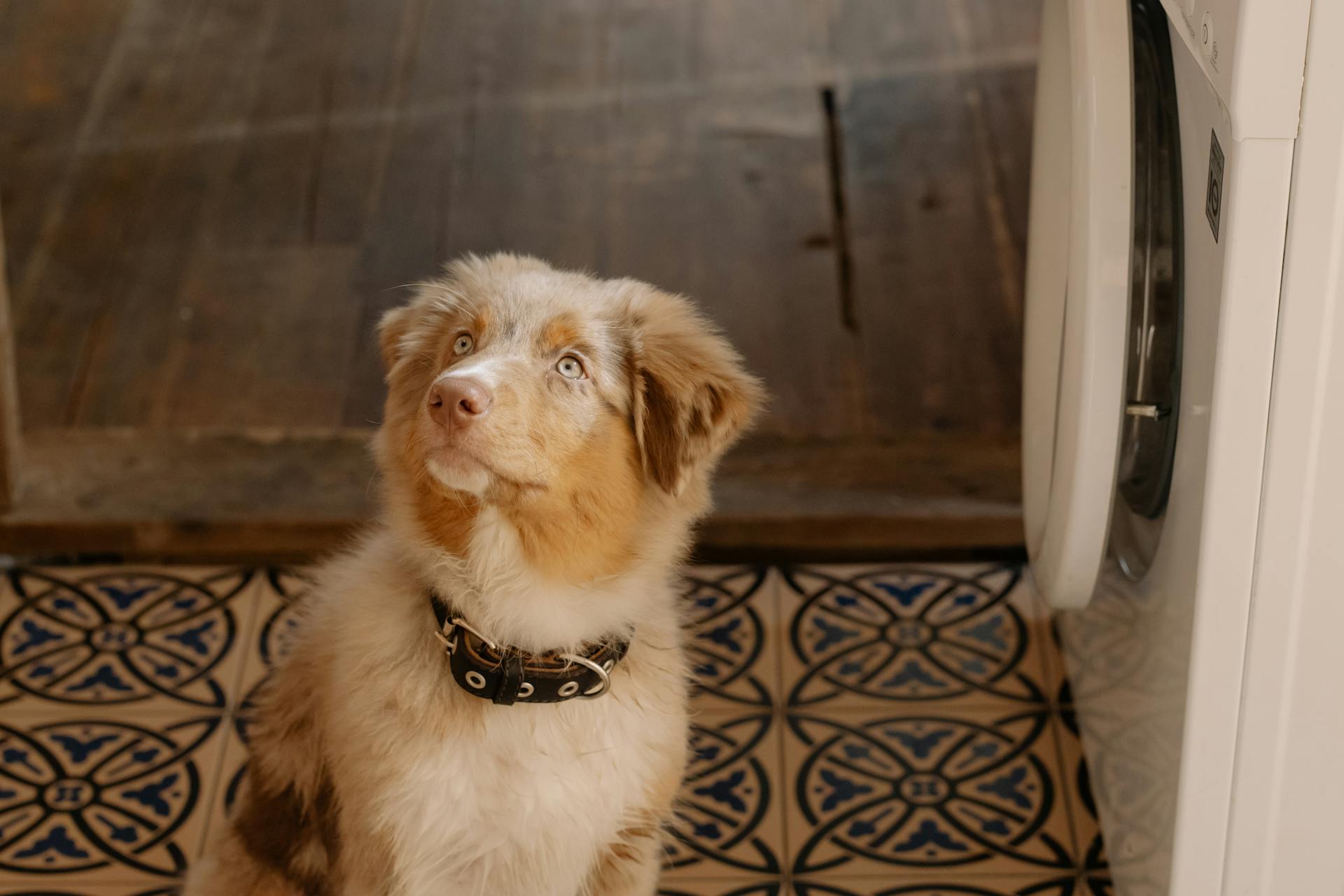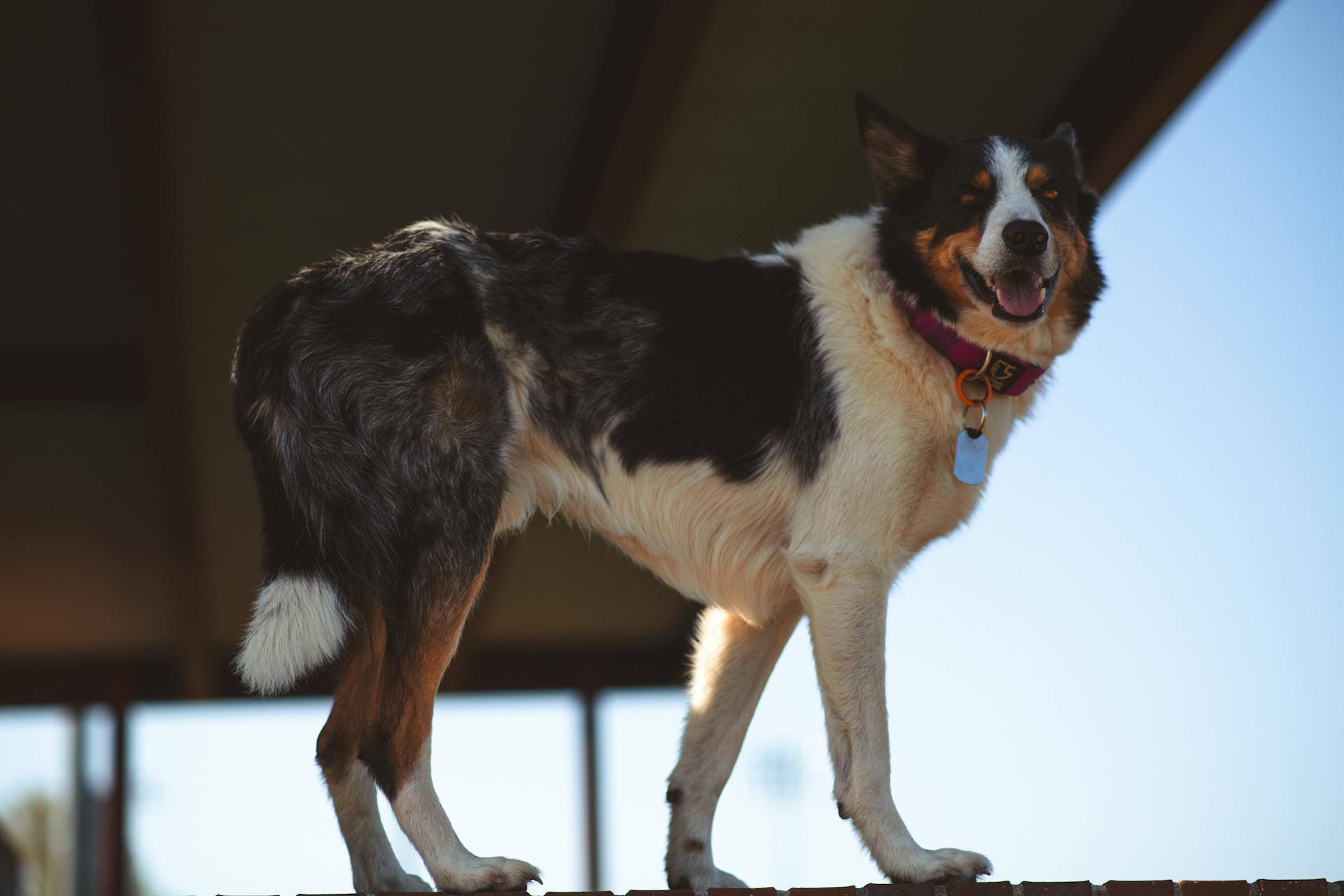
Mini Aussies are intelligent and energetic dogs that require regular exercise and mental stimulation to prevent boredom and destructive behavior. They thrive on interaction and need a lot of attention from their owners.
To start training a mini Aussie, begin with short sessions of 10-15 minutes, two to three times a day, to keep them engaged and prevent overexertion. This will help them build focus and concentration.
Mini Aussies are highly social dogs and need early socialization to become confident and calm in new situations. This can be achieved by exposing them to various environments, people, and other animals from an early age.
By following these simple guidelines, you can set your mini Aussie up for success and create a strong foundation for a lifelong bond.
Recommended read: Mini Bernedoodle Dogs
Potty Training Basics
Mini Aussies aren't as hard to potty train as you might think. They're actually quite intelligent and eager to please.
However, their smaller bladders mean they'll need to go outside more often than larger dogs. You can't expect them to hold it as long as bigger dogs, so be prepared for more frequent trips outside.
Potty training a Mini Aussie usually takes around four months, but it can take up to six months in some cases. Progress will be slow and steady, with occasional setbacks along the way.
These setbacks can be frustrating, but they're a normal part of the learning process. Sometimes, your Mini Aussie might regress due to stress or changes in routine, or even underlying health issues like UTIs.
To help your Mini Aussie learn, you'll need to wait for their bladder to grow and their bladder control to strengthen. There's not much you can do to speed up this process, but with patience and consistency, they'll get there eventually.
Here are some common potty training mistakes to watch out for:
- Not taking your Mini Aussie outside often enough
- Not watching for signs that they need to go (like sniffing or circling)
- Not rewarding good behavior (like going potty outside)
Training Techniques
Mini Aussies are highly intelligent and trainable, but they can be strong-willed and independent. They thrive on positive reinforcement and clear boundaries.
Housebreaking is a crucial aspect of Mini Aussie training, and consistency is key. According to the article, Mini Aussies can hold their bladder for about 2 hours, but accidents will happen if they're not taken out often enough.
Positive reinforcement training methods are ideal for Mini Aussies, as they respond well to rewards and praise. Treats and affection can be used to encourage good behavior.
Mini Aussies are naturally herding dogs and may have a strong prey drive, so it's essential to socialize them well to other animals and people. Early socialization is crucial to prevent fear and aggression.
Mini Aussies are highly energetic and require regular exercise to stay happy and healthy. A daily walk of at least 30 minutes is recommended to keep them physically and mentally stimulated.
Considerations
As you begin mini Aussie training, consider the breed's high energy level and strong herding instinct. This means they require regular exercise and mental stimulation to prevent boredom and destructive behavior.
Mini Aussies are intelligent and responsive to positive reinforcement training methods, which can help you build a strong bond with your dog. With consistency and patience, you can teach your mini Aussie to obey basic commands and behave well in public.
Remember, mini Aussies are naturally protective of their family and territory, so early socialization is crucial to help them become confident and calm in new situations.
Consider Its Instinct
You can start by limiting your puppy's surroundings to prevent accidents in unwanted areas. Installing doggie-doors and restricting access to certain areas can help. Designate a specific space for your puppy to call their own, and another area for them to play, sniff, and socialize.
A floor that's easy to clean is essential in case of accidents. You can also use a crate, bed, mat, or other designated areas for your puppy to sleep in. This will help them understand that these areas are for sleeping and not for bathroom breaks.
Here are some key areas to consider when limiting your puppy's surroundings:
- Crate or designated sleeping area
- Eating area
- Play area
- Bathroom area (outside or designated potty area)
By understanding your puppy's instinct and creating a clear distinction between areas, you'll be well on your way to successful potty training.
Calming Insecurity
Insecurity can be a major obstacle to achieving our goals and living a fulfilling life. One way to calm insecurity is to focus on what we can control, such as our own thoughts and actions.

Research shows that people who practice mindfulness have lower levels of anxiety and insecurity. This is because mindfulness helps us stay present and focused on the moment, rather than getting caught up in worries about the future or past.
Focusing on our strengths and accomplishments can also help calm insecurity. By acknowledging and celebrating our successes, we can build confidence and self-esteem. For example, a person who excels at public speaking may feel more secure in their ability to communicate effectively.
By letting go of perfectionism, we can reduce feelings of insecurity. This means accepting that we're not perfect and that it's okay to make mistakes. As one person noted, "I used to beat myself up over every little mistake, but now I just learn from them and move on."
Practicing self-compassion is also essential for calming insecurity. This involves treating ourselves with kindness and understanding, just as we would a close friend. By being gentle and supportive with ourselves, we can develop a more positive and secure sense of self.
Frequently Asked Questions
How long does it take to house train a Mini Aussie?
House training a Mini Aussie typically takes 4-6 months, with gradual improvement over time. Consistency and patience are key to successful potty training.
Do Mini Aussies ever calm down?
Yes, Mini Aussies do calm down, but it takes a bit longer than most breeds, typically around two years old. With patience and proper training, they can learn to regulate their energy levels and become well-behaved adult dogs.
Are Mini Aussies hard to potty train?
Mini Aussies are generally easy to potty train due to their intelligence and quick learning ability. However, consistent dedication from the owner is still required to achieve successful training.
How do you train a Mini Australian Shepherd puppy?
Train a Mini Australian Shepherd puppy with reward-based, positive-reinforcement training that focuses on praise and rewards for desired behavior, rather than punishment for undesired behavior
Featured Images: pexels.com

